Moniek Bloks's Blog, page 44
July 6, 2024
Anna of Austria – Duchess of Bavaria
Anna of Austria was born on 7 July 1528 as the daughter of the future Ferdinand I, Holy Roman Emperor and Anna of Bohemia and Hungary. She was the third of their fifteen children.
Anna seemed fine just after her birth, but she fell ill shortly afterwards, and she received an emergency baptism as a result. This baptism was performed by Bishop Bernhard Cles von Trient, who was the court chancellor. Due to her health, she was breastfed by a wet nurse for quite some time, and it was reported she still had one at 16 months.1
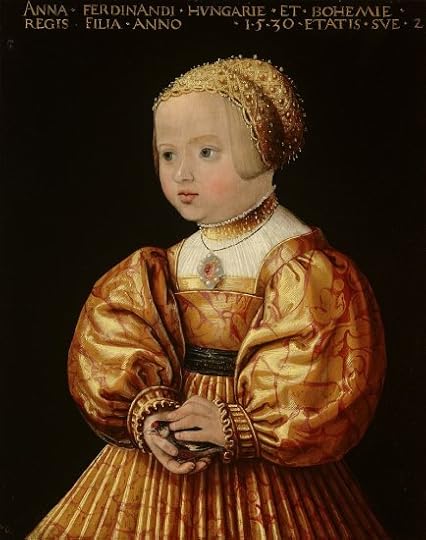 (public domain)
(public domain)Already in the summer of 1531, Anna was being considered as part of an alliance, and Cardinal Matthaus Lang proposed a match between the five-year-old Prince Theodor of Bavaria and three-year-old Anna. However, her father did not agree with the proposal and no agreement was reached. Young Theodor died in 1534, but the Bavarian match was revived later that year with a replacement groom, Theodor’s six-year-old brother Albert. The bride was initially to be Anna’s Maria, but any of the sisters were also a possibility. In the meantime, another match was planned for Anna with Charles, Duke of Orléans – the third son of King Francis I of France. He died in 1545.
After this, Ferdinand pressed for the match between Anna and Albert to take place while another groom was sought for Maria. During the Diet of Regensburg in 1546, both marriages were finally arranged. On 4 July 1546, Anna married Albert, the heir to the Bavarian throne. Her brother Maxilimian accompanied her to Munich, where “Anna saw herself loved and pampered by all her relatives.”2
For the first few years of their marriage, the couple lived at Trausnitz Castle in Landshut. Albert succeeded his father as Duke of Bavaria in 1550. Anna and Albert had seven children together, of which five children lived to adulthood: William (born 1548), Ferdinand (born 1550), Maria Anna (born 1551), Maximiliana Maria (born 1552), Ernst (born 1554), She was a strict mother and did not shy away from corporal punishment.3 Anna kept a close correspondence with her sister-in-law, Maria, the wife of her brother, the future Maximilian II, Holy Roman Emperor.
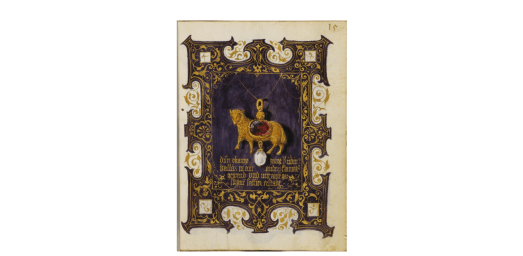 (public domain)
(public domain)Anna and Albert became religious and cultural patrons and even laid the foundation of the Bavarian State Library. In 1552, Anna and Albert commissioned an inventory of all the jewellery they owned, and the subsequent inventory and drawings have survived to this day in the Kleinodienbuch der Herzogin Anna von Bayern.
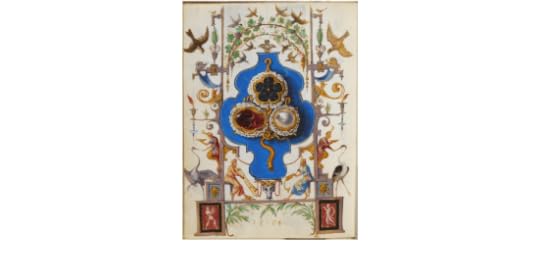 (public domain)
(public domain)After she was widowed in 1579, Anna maintained her own court at the Residence in Munich. Anna died on 16 October 1590 in Munich. She is buried in the crypt of the Frauenkirche, which is currently closed.
 Photo by Moniek Bloks
Photo by Moniek Bloks
The post Anna of Austria – Duchess of Bavaria appeared first on History of Royal Women.
Book News Week 28
Book News Week 28 – 8 July – 14 July 2024
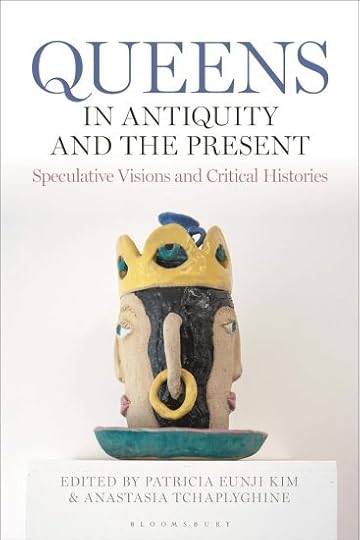
Queens in Antiquity and the Present: Speculative Visions and Critical Histories
Hardcover – 11 July 2024 (UK)
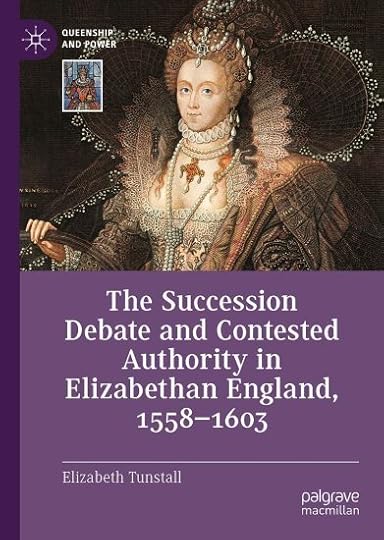
The Succession Debate and Contested Authority in Elizabethan England, 1558-1603 (Queenship and Power)
Hardcover – 13 July 2024 (US)
The post Book News Week 28 appeared first on History of Royal Women.
July 4, 2024
The Year of Isabella I of Castile – The death of her brother Alfonso
On 5 July 1468, the future Queen Isabella I of Castile mourned the loss of her only full sibling, Alfonso. His death paved the way for her to become the face of the rebellion.
Alfonso was born on 17 November 1453, when Isabella was two years old. Due to male-preference primogeniture, he would precede her in the line of succession to eventually succeed their much older half-brother, King Henry IV of Castile. Alfonso and Isabella lost their father, King John II of Castile, in 1454, upon which Henry became King.
Isabella, Alfonso and their mother moved to Arévalo, where they lived in a two-story house. The town was known for its clean air, and “the plague was rarely known here.”1 For their mother, these were dark days, and she reportedly shut herself “in a dark room, condemning herself to silence.”2 They were soon joined in Arévalo by Isabella of Barcelos, their maternal grandmother. It was Isabella of Barcelos who oversaw their early childhood and education. Alfonso and his sister grew close during this time.
The family spent quite a few quiet years at Arévalo, but as King Henry’s wife Joan came close to giving birth, Henry wanted any potential challengers for the throne kept close by. The ten-year-old Isabella and seven-year-old Alfonso were recalled to court. Isabella later wrote, “Alfonso and I, who were just children at the time, were inhumanely and forcibly torn from our mother’s arms and taken into Queen Juana (Joan)’s power.”3
Isabella and Alfonso said goodbye to their mother and grandmother at the end of 1461 to travel to the court at Segovia. On 28 February 1462, the Queen gave birth to a daughter – Joanna. Isabella acted as godmother for her newborn niece. Joanna was their first child after seven years of marriage and would prove to be the only surviving child. However, it appears that several nobles already doubted Joanna’s legitimacy, not in the least because of jealousy towards Beltrán de la Cueva, who held the King’s favour. It is impossible to tell if Joanna was Beltrán de la Cueva’s daughter, but we know Joan conceived again within the year.
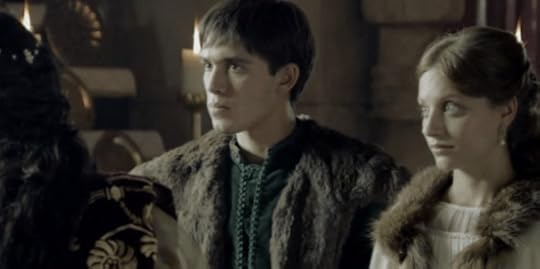 Alfonso and Isabella arrive at court as portrayed in Isabel (2011) (Screenshot/Fair Use)
Alfonso and Isabella arrive at court as portrayed in Isabel (2011) (Screenshot/Fair Use)Three months later, Henry had Joanna sworn in as the heiress to the throne, and Isabella and her brother Afonso were the first ones to swear. Isabella later claimed that she knew why some nobles said that they had sworn against their will. She wrote, “It was something she [the Queen] had demanded because she knew the truth about her pregnancy and was taking precautions.”4
Nevertheless, the allegations surrounding Joanna’s paternity were the perfect breeding ground for a rebellion. Joanna was just two years old when a manifesto of complaints and grievances was issued against King Henry by several nobles. This led to the Representation of Burgos in 1464, where Henry was forced to recognise Alfonso as the legitimate heir. This was agreed upon with the condition that Alfonso would one day marry Joanna. However, Henry soon reconsidered, and this led to a ceremonial deposition in effigy in 1465, and the 11-year-old Alfonso was crowned as rival King.
Isabella and Alfonso were reunited in 1467 when he triumphantly rode into Segovia as Queen Joan fled. She later wrote, “I stayed in my palace, against the queen’s will, in order to leave her dishonest custody that was bad for my honour and dangerous for my life.”5 She made Alfonso’s counsellors sign a document stating that she would not be forced into marriage before agreeing to come with them.
Isabella also asked to return to her mother at Arévalo, and at the end of the year, they celebrated Alfonso’s 14th birthday with the three of them. They stayed there until they were forced to flee due to an outbreak of the plague at the end of June 1468. Alfonso fell ill at Cardeñosa, and for four days, he fought for his life. His death was expected, and Isabella wrote, “And you all know that in the moment that the Lord decided to take his life, succession of the kingdoms and royal lands of Castile and Leon will, as his legitimate heiress and successor, pass to me.”6
Alfonso died on 5 July 1468. The battle was now between Joanna and Isabella.
The post The Year of Isabella I of Castile – The death of her brother Alfonso appeared first on History of Royal Women.
July 2, 2024
Princess Ai Jiang -The depraved Princess
Princess Ai Jiang was the wife of Duke Zhuang of Lu. She has often been described as “proud, lustful, corrupt, evil, and perverse.”[1] She has been known for her love affair and for trying to murder her husband’s children.[2] Despite her evil actions, her stepson was merciful towards her, especially after her death. He even forgave her ruthless actions. Despite his mercy, Princess Ai Jiang will be remembered as one of China’s most “depraved women.”[3]
Princess Ai Jiang was born during the Spring and Autumn period, which lasted from 771 to 453 B.C.E. During this period, Chinese states were declaring their own independence from the ruling Zhou Dynasty to form their own dynasties.[4] Princess Ai Jiang’s exact birthdate is unknown. She was a Princess of the State of Qi.[5] Her first name means “sorrowful.”[6] She was the daughter of Duke Xiang of Qi. She did have a younger sister named Princess Shu Jiang, which means “third-born daughter”[7].
In 670 B.C.E., Princess Ai Jiang was married to Duke Zhuang of Lu. Duke Zhuang of Lu was Princess Ai Jiang’s first cousin.[8] His mother was Princess Wen Jiang, who was Princess Ai Jiang’s aunt.[9] It also meant that Duke Zhuang was marrying the daughter of the man who killed his father.[10] The marriage was arranged three years before, in 673 B.C.E. One historical source stated that Princess Ai Jiang already had frequent illicit liaisons with her future husband before she went to Lu.[11] Princess Ai Jiang was accompanied by her younger sister, Princess Shu Jiang.[12] Princess Ai Jiang married Duke Zhuang of Lu. She became the Duchess of Lu. Princess Shu Jiang became Duke Zhuang’s concubine.
Even though Duchess Ai Jiang was married to Duke Zhuang for a long time, she failed to produce children.[13] Her sister already had a son named Prince Qi (the future Duke Min of Lu).[14] Duchess Ai Jiang wanted to make Prince Qi the heir apparent.[15] However, he already had an heir apparent named Prince Ban. She turned to her brother-in-law, Prince Qingfu, for help.[16] Prince Qingfu was very handsome, and Duchess Ai Jiang was very attracted to him.[17] She became his lover. However, when Duke Zhuang of Lu discovered the affair, he was enraged.[18] Duchess Ai Jiang had to flee Lu.[19]
In 662 B.C.E., Duke Zhuang of Lu died. This allowed Prince Qingfu to make Duchess Ai Jiang’s wishes come true.[20] He killed the heir apparent and made Prince Qi the new Duke.[21] He became Duke Min of Lu. Duke Min of Lu allowed Duchess Ai Jiang to return to Lu.[22] She continued her affair with Prince Qingfu.[23] However, Prince Qingfu wanted to become the Duke of Lu instead.[24] Duchess Ai Jiang decided to support him.[25] They plotted to assassinate Duke Min of Lu.[26] When the assassination plot was discovered, Duchess Ai Jiang fled to Zhu.[27] Prince Qingfu fled to Qu, where he later committed suicide.[28]
In 659 B.C.E., Duke Huan of Qi decided to intervene in the state affairs of Lu.[29] He made Duke Zhuang Liu’s son from another concubine, Prince Shen, the Duke instead.[30] He became Duke Xi of Lu. Then, Duke Huan ordered Duchess Ai Jiang to be assassinated.[31] The army of Qi caught Duchess Ai Jiang and killed her. They took her body back to Qi. However, Duke Xi requested Duchess Ai Jiang’s body to be sent back to Lu.[32] They buried her there with honours befitting a Duchess.[33] In 652 B.C.E., Duchess Ai Jiang’s ancestral tablet was placed in the Grand Temple.[34]
Many chroniclers have often viewed Princess Ai Jiang’s murder as “too severe.”[35] They believed that she should have been dealt with by Duke Xi of Lu rather than Duke Huan of Qi.[36] Princess Ai Jiang committed many treacherous acts. Yet, Duke Xi was very merciful to her. He buried her with the honours of a Duchess and honoured her by placing her tablet in the temple. Even though Duke Xi forgave her, history has not. In the Biographies of Eminent Women, Princess Ai Jiang’s biography is categorised in the section of “Biographies of Pernicious and Depraved Women.”[37] Thus, Princess Ai Jiang will always be remembered for her evil actions.[38]
Sources:
Cook, C.A. (2015). “Ai Jiang, Wife of Duke Zhuang of Lu”. Biographical Dictionary of Chinese Women: Antiquity Through Sui, 1600 B.C.E. – 618 C.E. (L. X. H. Lee, Ed.; A. D. Stefanowska, Ed.; S. Wiles, Ed.). NY: Routledge. p. 3.
Eno, R. (2010). 1.7. Spring and Autumn China (771-453). Indiana University, PDF.
Liu, X., Kinney, A. B. (2014). Exemplary Women of Early China: The Lienü Zhuan of Liu Xiang. United Kingdom: Columbia University Press.
[1] Cook, 2015, p. 3
[2] Cook, 2015
[3] Cook, 2015, p. 3
[4] Eno, 2010
[5] Cook, 2015
[6] Liu & Kinney, 2014, p. 264
[7] Liu & Kinney, 2014, p. 264
[8] Liu & Kinney, 2014
[9] Liu & Kinney, 2014
[10] Liu & Kinney, 2014
[11] Cook, 2015
[12] Cook, 2015
[13] Cook, 2015
[14] Cook, 2015
[15] Cook, 2015
[16] Cook, 2015
[17] Liu & Kinney, 2014
[18] Cook, 2015
[19] Cook, 2015
[20] Cook, 2015
[21] Cook, 2015
[22] Cook, 2015
[23] Cook, 2015
[24] Cook, 2015
[25] Cook, 2015
[26] Cook, 2015
[27] Cook, 2015
[28] Cook, 2015
[29] Cook, 2015
[30] Cook, 2015
[31] Cook, 2015
[32] Cook, 2015
[33] Cook, 2015
[34] Cook, 2015
[35] Cook, 2015, p. 3
[36] Cook, 2015
[37] Cook, 2015
[38] Cook, 2015
The post Princess Ai Jiang -The depraved Princess appeared first on History of Royal Women.
July 1, 2024
Royal Wedding Recollections – The Prince of Liège & Paola Ruffo di Calabria
On 2 July 1959, the future King Albert II of Belgium, then known as the Prince of Liège, married the Italian-born Donna Paola Ruffo di Calabria. They had met in the Vatican in 1958 during the coronation of Pope John XXIII.
Albert was the younger brother of King Baudouin of Belgium, who would marry Fabiola de Mora y Aragón in 1960. This marriage remained childless, as Fabiola had several miscarriages. During this time, Albert was the heir presumptive to the throne.
Initially, Pope John XXIII was to perform the wedding in Rome personally, but this idea caused diplomatic issues. The New York Times reported, “Pope John XXIII has decided ‘in a gesture of especial solicitude toward Belgium’ that the wedding should take place here.”1 And so, the wedding was set to take place in Brussels.
Embed from Getty ImagesThe civil wedding occurred in the Empire Salon at the Royal Palace in Brussels, while the religious ceremony occurred at the Cathedral of St. Michael and St. Gudula. Prince Albert wore the uniform of a naval officer, and Paola wore a white satin gown with a five-metre train and a lace veil that had belonged to her Belgian grandmother, Laura Mosselman du Chenoy. This veil was later worn by her daughter Astrid and daughters-in-law Mathilde and Claire. The designer of her gown is not known.
Instead of a tiara, Paola wore orange blossoms in her hair.
Paola and Albert went on to have three children together, but the marriage was not without its difficulties. In 1968, Albert’s illegitimate daughter, Delphine, was born. The couple was on the brink of a divorce but came together again. Albert became King of the Belgians upon the death of his brother in 1993. He abdicated in 2013.
The post Royal Wedding Recollections – The Prince of Liège & Paola Ruffo di Calabria appeared first on History of Royal Women.
June 30, 2024
The Year of Isabella I of Castile – Maria of Aragon, An overshadowed Queen (Part two)
After a proxy wedding, Maria left Castile as Queen of Portugal on 23 September 1500. Her parents travelled with her to Santa Fe, where they said their goodbyes. She would never see them again. Maria entered Portugal through the town of Mouro on 20 October 1500. She met her new husband at Alcácer do Sal, where the in-person wedding occurred on 30 October. Maria kept in close contact with her mother until her mother died in 1504.
 Maria and Manuel as portrayed in Isabel (2011) (Screenshot/Fair Use)
Maria and Manuel as portrayed in Isabel (2011) (Screenshot/Fair Use)During the early days of her marriage, Maria was often in the company of her mother- and sister-in-law, Beatrice of Portugal, Duchess of Viseu and Isabella, Duchess of Braganza, and she appeared to enjoy their company.1
Maria was known to have been a quiet and docile woman who did not resist the influence of her sister-in-law, the widow of her husband’s predecessor, Queen Eleonor. She was not politically active, although she was present at audiences and ceremonies of the court.
Maria and Manuel’s first child was born on 6 June 1502. He would be the future King John III. Maria went on to have ten children in total, of which six sons and two daughters would survive to adulthood. As a mother, Maria closely monitored the education of her children. The children were fed by wetnurses as was usual, but Maria kept her children close to her. According to one chronicler, “She chastised the prince (John) and her children when they deserved it, without forgiving any of them, to whom she always showed equal love, making no difference other than the precedence of age at which each one was.”2
Elaine Sanceau wrote, “While parents and diplomats discussed their future fate, the young Infantes were carefully brought up at court. Their mother, Queen Maria, grave-eyed, self-effacing, virtuous, always busy about the works of religion and charity, plying her skilful needle in the most beautiful embroidery, kept a close watch on all her children, guiding them in the way they should go, nor sparing to punish them whey they deserved it.”3
Maria’s mother, Queen Isabella, died when Maria was heavily pregnant with her third child, and “almost in the final days of her expected labour”, and the devastating news was kept from her.4 The child was named Beatrice, as her elder sister already carried the name of her famous grandmother, Isabella. It is unclear how much Maria knew about the mental state of the new Queen of Castile, her sister Joanna, and the following power struggle between Joanna’s husband Philip and their father, Ferdinand.
In 1506, plague struck the city of Lisbon, and the Lisbon Massacre of the Jews took place and Maria left the city to safely wait out the birth of her fourth child, a son named Luis. That same year, Joanna’s husband, Philip, died suddenly at the age of 28. Their father won the power struggle, and Joanna was confined in Tordesillas from 1509. Meanwhile, Maria moved into the newly built Ribeira Palace.
In early 1516, Maria’s father, Ferdinand, died, but we do not know what their contact was like during Maria’s years in Portugal as there are no surviving letters. We do know that she ordered the appropriate mourning clothes.
On 8 September 1516, Maria gave birth to her final child, a son named António. He was baptised the following Wednesday “because the infant was ill, and for this reason, he was baptised without ceremony.”5 He lived for just under two months, and he was buried without ceremony in Belém. Maria had not come out of this last childbirth without injury, and she suffered horrible pains for months. She managed to attend the confirmation of three of her sons in October 1516 in a great deal of pain. It is not clear what exactly Maria was suffering from, although cancer may have played a part.6
Maria died on 7 March 1517 at the age of 34. Manuel was so grieved that he retired to a monastery for a while. In response to her death, he also made his will. Maria’s body was carried by a mule to the Convent of Madre Deus at night, covered with a black velvet cloth with a white cross.7 Her coffin was placed in a chapel next to the cloister. The nuns removed her robes and put her in the habit of St Francis before she was buried in the chapel. Her remains were moved to the Jerónimos Monastery in 1551.
Maria has been tragically overshadowed by her more famous parents and siblings. Even in Portugal, she was overshadowed by two other Queens: Queen Eleanor, who signed her name “rainha”, Joanna la Beltraneja who signed her name “Yo la Rey-na.” Maria herself signed with “reyna” or “la reyna”, which makes it difficult to distinguish between them. There are also no complete account books to overview Maria’s purchases. Nevertheless, her legacy passed through her children. Her eldest daughter, Isabella, became Holy Roman Empress as the wife of Joanna’s son, Charles. Her eldest son, John, succeeded his father as King of Portugal and married Joanna’s daughter, Catherine.
In 1518, Maria’s husband remarried Joanna’s daughter, Eleanor, and had one further surviving child with her. King Manuel died in 1521.
The post The Year of Isabella I of Castile – Maria of Aragon, An overshadowed Queen (Part two) appeared first on History of Royal Women.
June 29, 2024
Book News Week 27
Book News week 27 – 1 July – 7 July 2024

Catherine de’ Medici: The Life and Times of the Serpent Queen
Hardcover – 2 July 2024 (US)
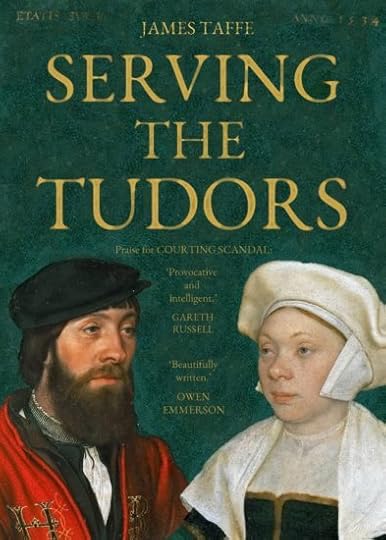
Serving The Tudors
Kindle Edition – 1 July 2024 (US & UK)
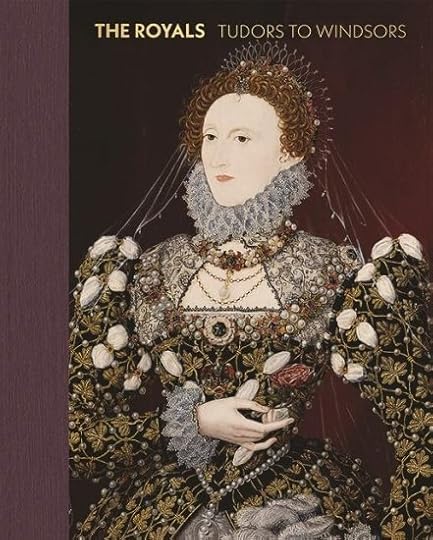
The Royals: Tudors to Windsors
Hardcover – 4 July 2024 (UK)
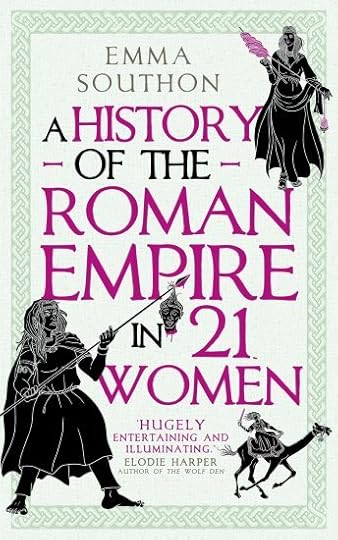 A History of the Roman Empire in 21 Women
A History of the Roman Empire in 21 Women
Paperback – 4 July 2024 (UK)

Majapahit: Intrigue, Betrayal and War in Indonesia’s Greatest Empire
Paperback – 1 July 2024 (UK)
The post Book News Week 27 appeared first on History of Royal Women.
Taking a look at Alexandra, Countess of Frederiksborg as she turns 60
Alexandra Christina Manley was born on 30 June 1964 in Hong Kong, the daughter of Richard Nigel Manley and Christa Maria Nowotny. She has two younger sisters.
Alexandra attended her early schooling in Hong Kong and studied international business at the Vienna University of Economics and Business in Austria. She worked for GT Management between 1990 and 1995.
She met Prince Joachim of Denmark, the younger son of Queen Margrethe II of Denmark, during a dinner party in Hong Kong in 1994. Their engagement was announced in May 1995.
Embed from Getty ImagesAlexandra and Joachim were married on 18 November 1995 in Frederiksborg Castle Church, and the festivities were held at Fredensborg Palace. Alexandra wore a gown designed by Jørgen Bender and the Alexandrine Drop Tiara, given to her by her new mother-in-law. After her marriage, Alexandra was styled as Her Royal Highness Princess Alexandra of Denmark.
Embed from Getty ImagesThe couple went on to have two sons: Nikolai (born 1999) and Felix (born 2002). Their sons were initially styled as Princes but currently hold the title of Count of Monpezat.
Embed from Getty ImagesAlexandra became a popular member of the Danish Royal Family, and she quickly learned to speak Danish. She later said, “It was my decision to learn the language immediately. It would have been terrible to have to stand up and speak English at an engagement, or thank someone for something. It would have been utterly wrong. This is my home, and so there was no other option.”1 She also took up a number of charitable causes, which she retains to this day.
Embed from Getty ImagesIn September 2004, Joachim and Alexandra announced their separation and intention to divorce. “After many difficult considerations, we have jointly decided to separate with the intention of seeking a divorce. We are in agreement over the terms of the separation, and we intend to share in the upbringing of our children,” they said in a joint statement.2 Alexandra was granted a civil list income for life, which remained independent of any future remarriage. After the divorce in 2005, Alexandra became known as Her Highness, and she was granted the additional title of Countess of Frederiksborg.
Embed from Getty ImagesAlexandra remarried to Martin Jørgensen on 3 March 2007 in a private ceremony. As a result, she lost the style of Her Highness and the title of Princess. She has since been known as Her Excellency Alexandra, Countess of Frederiksborg. In September 2015, this marriage also ended in divorce.
Embed from Getty ImagesAlexandra still attends family events with the Danish royal family but she is now largely a private person. In 2017, she announced that she would end her income from the civil list in July 2020, when her youngest son turned 18 years old.
Prince Joachim remarried to Marie Cavallier in 2008 and had a further two children with her.
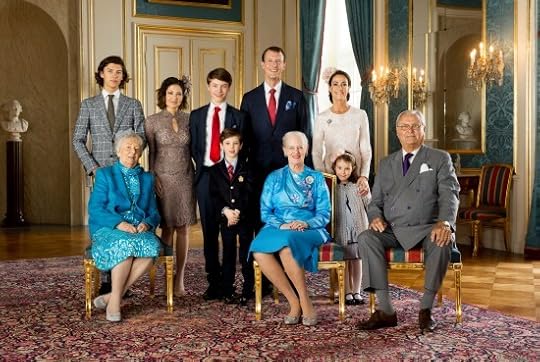 Photo: Steen Brogaard, Kongehuset ©
Photo: Steen Brogaard, Kongehuset ©
The post Taking a look at Alexandra, Countess of Frederiksborg as she turns 60 appeared first on History of Royal Women.
The Year of Isabella I of Castile – The tragic fate of John, Prince of Asturias
On 30 June 1478, Queen Isabella I of Castile finally got her wish after a daughter and a miscarriage – a healthy son was born. He was named John or Juan. He would later be joined by another three sisters.
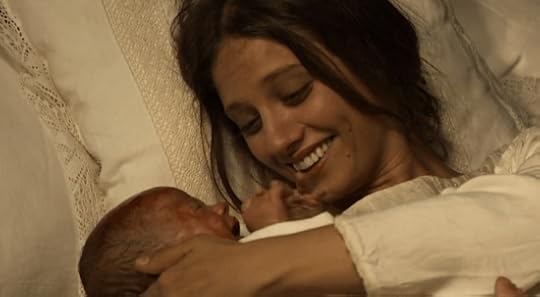 The scene as portrayed in Isabel (2011) (Screenshot/Fair Use)
The scene as portrayed in Isabel (2011) (Screenshot/Fair Use)Nine days after his birth, John was carried by a governess in a procession with grandees and bishops to the Santa Maria la Mayor Cathedral, where he was baptised. The chronicler Pulgar wrote, “The queen has paid off the debt of providing this kingdom with a male heir. He [God] chose not from the tribe of Alfonso nor, because he rejected the tabernacle of God, from Enrique [Henry]. He chose instead the tribe of Elisabeth [meaning Isabella], which he loved.” 1 John’s parents were still deep in the succession war with Isabella’s niece, Joanna, and John’s birth seemed to prove that God was on Isabella’s side. Little John was installed in the court with his wet nurse, Maria de Guzman.
After negotiations with Joanna, she was forced to choose between an engagement with Isabella’s newborn son, which he could renege on when he was 14, or taking a nun’s vows and entering a cloistered Portuguese convent. The 18-year-old Joanna chose to enter a convent.
John, as the heir, received Isabella’s special attention. She routinely called him “My angel”, even if she was mad at him.2 She had appointed Juana de la Torre as his ama or nurse, and he had become quite close to her. When John was 11, his household was separated from that of his mother, and by the time of his marriage, he had his own court at Almazan. As a young boy, he was carried in a litter by servants as the court moved around. When he was a little older, he would ride his own mule. He was provided with bullfights, music, fireworks and chess as his entertainment.
When he was seven years old, Diego de Deze, a Dominican tutor, was appointed to him. He taught him Latin, grammar, ethics, reading and music.3 He was often in his parents’ company and learned from them as well. In 1496, shortly before the weddings of his sisters Isabella and Joanna, John was named Prince of Asturias.
 Isabella and John as portrayed in Isabel (2011) (Screenshot/Fair Use)
Isabella and John as portrayed in Isabel (2011) (Screenshot/Fair Use)It was soon time for him to marry as well, and he had been part of a double negotiation. His bride, Margaret of Austria, would be brought back on the fleet that had taken his sister Joanna to her groom. However, the weather was quite adverse, but a route over land was not possible due to the political tensions.
On 22 January 1497, it was decided to set sail, even though the weather was still not ideal. The ships were forced to land near the English coast during a storm. King Henry VII immediately sent food and aid, and the ships were forced to wait for three weeks. During a second attempt, Margaret’s ship hit another ship, and a terrified Margaret jumped from the ship into a boat. During the third attempt, many ships in the fleet were destroyed during subsequent storms, and Margaret wrote this melancholic verse, “Here lies Margaret, the willing bride, twice married but a virgin when she died.”4
On 6 March 1497, two ships limped into the harbour of Santander, and one of them carried Margaret. Margaret met her future mother-in-law, Queen Isabella I of Castile, in Burgos shortly after her arrival. Margaret tried to kneel and kiss Isabella’s hand, but Isabella raised her up. The Venetian ambassador later wrote, “The Queen’s reception of her was quite a sight. Kissing and hugging many times, she took her with her.” 5 Margaret was dressed in a “French-style dress of gold brocade and crimson lined with ermine, topped off by a black felt hat and accompanied by large pearls.” 6
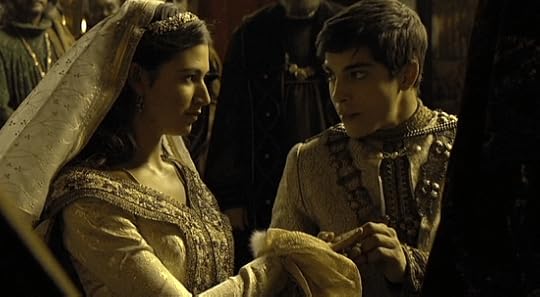 Margaret and John as portrayed in Isabel (2011)(Screenshot/Fair Use)
Margaret and John as portrayed in Isabel (2011)(Screenshot/Fair Use)On 19 March 1497, Margaret and John were married, although they had to wait two weeks to consummate the marriage as it was Lent. They took to each other immediately, and physicians began to worry about the time the couple spent in bed together. Margaret wrote home to her father how happy she was and that her tears “were not out of sadness.” 7 Prince John was “a prisoner to his love for the lady, our young prince is once more too pale.” 8 Physicians advised to separate the two from time to time, but Isabella told them that it was not right for man to separate what God has joined.9 And so, John’s health declined at an alarming rate.
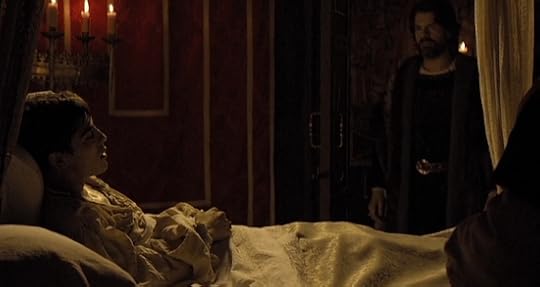 The scene as portrayed in Isabel (2011) (Screenshot/Fair Use)
The scene as portrayed in Isabel (2011) (Screenshot/Fair Use)On 29 September, Queen Isabella was informed that her son was dangerously ill, and King Ferdinand arrived just in time to say goodbye to his dying son. On 4 October 1497, John died at the age of 20 at the Bishop’s Palace in Salamanca. They had just learned of Margaret’s pregnancy.
Isabella devoted herself to looking after Margaret. She and Ferdinand wrote, “Our devotion to the princess only grows, as she tries hard and so sensibly, just as [the person] she is, and we will work to console her and to make her happy as if she had lost nothing. She is healthy with her pregnancy, thank God, and we that – by His mercy – the fruit that emerges from her will be consolation and repair for our woes. We care and will care for the princess just as if her husband were still alive, for we hold her in that place and love forever.” 10
After a pregnancy of seven months, Margaret went into premature labour. In April 1498, a stillborn daughter was born. One courtier bluntly wrote, “Instead of bearing the much-desired offspring, she offered us a dead child.” 11
John was buried in the Real Monasterio de Santo Tomás in Ávila. His position as the heir now passed to his eldest sister, Isabella.
The post The Year of Isabella I of Castile – The tragic fate of John, Prince of Asturias appeared first on History of Royal Women.
June 28, 2024
The Year of Isabella I of Castile – Maria of Aragon, An overshadowed Queen (Part one)
Maria of Aragon was born on 29 June 1482 as the daughter of Queen Isabella I of Castile and King Ferdinand II of Aragon. Her mother had been pregnant with twins, and Maria’s twin was stillborn a day and a half later. It is unclear if her twin was a boy or a girl. Maria had two elder sisters and an elder brother. Another sister named Catherine was born in 1485.
 The scene as portrayed in Isabel (2011) (Screenshot/Fair Use)
The scene as portrayed in Isabel (2011) (Screenshot/Fair Use)Queen Isabella was noted by foreign diplomats as having an affectionate relationship with her children. For example, an envoy from France noted that Queen Isabella held the infant Catherine in her lap during a bullfight and lovingly interacted with her.1 However, she was known to be a demanding mother, and she monitored their education. They learned about etiquette and protocol from an early age, but as a younger daughter, she was frequently left behind during state events. Her early years were spent in lessons and prayer.
Isabella planned a suitable education for her children, and Maria and her sisters studied Latin under Beatriz Galindo, a scholar. Queen Isabella founded a school of classics at the palace, and while this was mostly attended to educate noblemen and noblewomen, her own children would have benefitted from its presence. Maria would have also studied history, civil and canon law, Scripture and literature. She would also learn to weave, spin, sew, embroider, dance, draw and cook. Maria and her sisters were being prepared for lives as consorts.
Maria was just eight years old when the first of the siblings left to be married. Queen Isabella’s namesake eldest daughter, Isabella, was to marry Afonso, Prince of Portugal. Just eight months later, Afonso died in a riding accident, and Isabella returned home with a broken heart. In 1492, Maria and her siblings were present when their parents triumphantly rode into Granada.
As Maria grew up, she would be considered for several matches, such as King James IV of Scotland. This was considered around the same time as her sister Catherine’s match with Arthur, Prince of Wales, and the idea was that the sisters could keep the peace. In 1495, Prince Afonso’s father died, and he was succeeded by his cousin Manuel, the same man who had accompanied Isabella to Portugal for her wedding. Manuel had grown attached to Isabella during their time together and wanted to marry her. However, Queen Isabella offered her younger daughter Maria instead. Manuel refused, saying it would be Isabella or he would look further. Isabella’s parents asked her to finally renounce her mourning and marry Manuel. However, Isabella insisted that she would never again “know another man.”2 The issue temporarily rested while the family focussed their attention on John and Joanna’s marriages.
 Maria and her mother, as portrayed in Isabel (2011) (Screenshot/Fair Use)
Maria and her mother, as portrayed in Isabel (2011) (Screenshot/Fair Use)In August 1496, Joanna left Castile to be married to Philip the Handsome, Duke of Burgundy, and the wedding took place on 20 October 1496. A few months after their wedding, Philip’s sister Margaret was sent to Castile to marry John. Their wedding occurred on 3 April 1497 and Margaret was an instant hit at court. John adored his new wife to the concern of his doctors that he was exhausting himself in the bed chamber. Meanwhile, Queen Isabella continued to negotiate with Manuel for him to accept Maria, but he still refused, wishing only for Isabella. Eventually, Isabella agreed to the match, though she asked for as little festivities as possible. She also requested that Manuel would expel all the Castilian conversos (those who had fled from Castile to Portugal due to the Inquisition), and he agreed, and he also agreed to expel Jews and Muslims. As her second wedding approached, it became clear that John was very ill. Manuel kept the news from Isabella so that she would not delay the wedding, and they were married on 30 September 1497.
John accepted his fate readily, asking only that his parents take care of Margaret, who was pregnant. He died on 4 October 1497 – still only 19 years old. The pregnant Margaret also fell ill, and Queen Isabella rushed to nurse her back to health. Nevertheless, the child she was carrying was born prematurely and died. This now left Isabella as the heir to the throne. By the time Manuel and Isabella returned to Castile to be sworn in as heirs to Castile, she was pregnant. This was a relief for the Aragonese, who would have preferred a man to inherit. If Isabella had a son, he would inherit everything. While at Zaragoza to discuss this matter, Isabella went into labour and gave birth to a son on 23 August 1498. However, she was still very malnourished from all the fasting she had done while in mourning, and she died within an hour of giving birth.
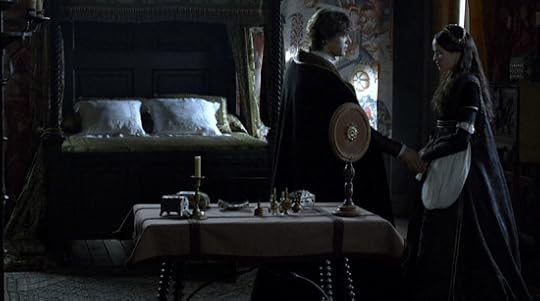 Maria and Manuel as portrayed in Isabel (2011) (Screenshot/Fair Use)
Maria and Manuel as portrayed in Isabel (2011) (Screenshot/Fair Use)Isabella’s son was named Miguel de la Paz, and he was granted Aragonese succession rights on top of the rights he had in Castile and Portugal. He was a sickly child and Manuel left him in the care of Queen Isabella while he returned to Portugal. On 19 July 1500, Queen Isabella held her young grandson as he, too, died.
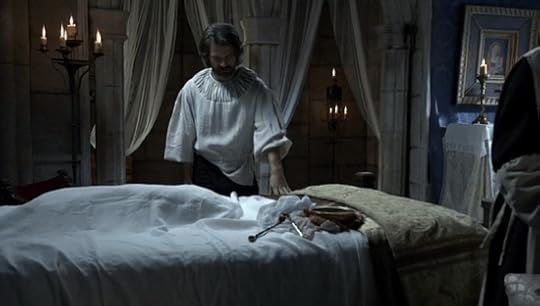 The death of Miguel de la Paz as portrayed in Isabel (2011) (Screenshot/Fair Use)
The death of Miguel de la Paz as portrayed in Isabel (2011) (Screenshot/Fair Use)This left Maria’s elder sister Joanna as the next heir, leaving King Manuel without a wife and an heir. Once again, Maria came back into the picture. She was her parents’ only available daughter, as her younger sister Catherine had already been promised to Arthur, Prince of Wales. Her parents had been proactive and had already applied for a papal dispensation, which arrived just a few days after the tragic death of Miguel de la Paz.
Part two coming soon.
The post The Year of Isabella I of Castile – Maria of Aragon, An overshadowed Queen (Part one) appeared first on History of Royal Women.



